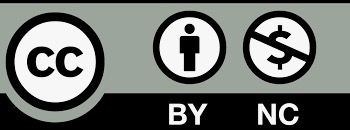Published
2023-10-31
Issue
Section
Research Articles
License
The journal adopts the Attribution-NonCommercial 4.0 International (CC BY-NC 4.0), which means that anyone can reuse and redistribute the materials for non-commercial purposes as long as you follow the license terms and the original source is properly cited.
Author(s) shall retain the copyright of their work and grant the Journal/Publisher rights for the first publication with the work concurrently licensed since 2023 Vol.8 No.2.
Under this license, author(s) will allow third parties to download, reuse, reprint, modify, distribute and/or copy the content under the condition that the authors are given credit. No permission is required from the authors or the publisher.
This broad license intends to facilitate free access, as well as the unrestricted use of original works of all types. This ensures that the published work is freely and openly available in perpetuity.
By providing open access, the following benefits are brought about:
- Higher Visibility, Availability and Citations-free and unlimited accessibility of the publication over the internet without any restrictions increases citation of the article.
- Ease of search-publications are easily searchable in search engines and indexing databases.
- Rapid Publication – accepted papers are immediately published online.
- Available for free download immediately after publication at https://esp.as-pub.com/index.php/ESP

Copyright Statement
1.The authors certify that the submitted manuscripts are original works, do not infringe the rights of others, are free from academic misconduct and confidentiality issues, and that there are no disputes over the authorship scheme of the collaborative articles. In case of infringement, academic misconduct and confidentiality issues, as well as disputes over the authorship scheme, all responsibilities will be borne by the authors.
2. The author agrees to grant the Editorial Office of Environment and Social Psychology a licence to use the reproduction right, distribution right, information network dissemination right, performance right, translation right, and compilation right of the submitted manuscript, including the work as a whole, as well as the diagrams, tables, abstracts, and any other parts that can be extracted from the work and used in accordance with the characteristics of the journal. The Editorial Board of Environment and Social Psychology has the right to use and sub-licence the above mentioned works for wide dissemination in print, electronic and online versions, and, in accordance with the characteristics of the periodical, for the period of legal protection of the property right of the copyright in the work, and for the territorial scope of the work throughout the world.
3. The authors are entitled to the copyright of their works under the relevant laws of Singapore, provided that they do not exercise their rights in a manner prejudicial to the interests of the Journal.
About Licence
Environment and Social Psychology is an open access journal and all published work is available under the Creative Commons Licence, Authors shall retain copyright of their work and grant the journal/publisher the right of first publication, and their work shall be licensed under the Attribution-NonCommercial 4.0 International (CC BY-NC 4.0).
Under this licence, the author grants permission to third parties to download, reuse, reprint, modify, distribute and/or copy the content with attribution to the author. No permission from the author or publisher is required.
This broad licence is intended to facilitate free access to and unrestricted use of original works of all kinds. This ensures that published works remain free and accessible in perpetuity. Submitted manuscripts, once accepted, are immediately available to the public and permanently accessible free of charge on the journal’s official website (https://esp.as-pub.com/index.php/ESP). Allowing users to read, download, copy, print, search for or link to the full text of the article, or use it for other legal purposes. However, the use of the work must retain the author's signature, be limited to non-commercial purposes, and not be interpretative.
Click to download <Agreement on the Licence for the Use of Copyright on Environmental and Social Psychology>.
How to Cite
Assessment of university students’ energy saving behavior by integrating stimulus-organism-response (SOR) and the theory of planned behavior (TPB)
Muhammad Umar Nadeem
SISU Intercultural Institute (SII), Shanghai International Studies University (SISU)
http://orcid.org/0000-0001-6613-6355
Ijaz Hussain Bokhari
School of Commerce and Accountancy, University of Management and Technology (UMT)
Anastassia Zabrodskaja
Baltic Film, Media and Arts School, Tallinn University
Matthew A. Koschmann
College of Media, Communication, and Information, University of Colorado Boulder
Steve J. Kulich
SISU Intercultural Institute (SII), Shanghai International Studies University (SISU)
DOI: https://doi.org/10.54517/esp.v8i3.2071
Keywords: energy saving behaviors, behavioral intensions, stimulus-organism-response, theory of planned behavior, Pakistan, university students
Abstract
This paper pretends to investigate the effectiveness of distance education during the COVID-19 pandemic time. Its objective was to analyze variables that impacted the results of emergency distance education, the challenges that arise for teacher training and comprehensive and inclusive education during and after pandemic periods. It corresponds to a documentary investigation, uses qualitative content analysis, and is framed in a stage of initial results on peer-reviewed academic articles from the Web of Science and websites of institutions relevant to the topic studied. The total sample was 70 articles. The results identify variables mostly studied in the scientific literature that affected distance learning, related to socio-emotional, motivational, self-regulation and executive skills of the students, along with those coming from particular family and social contexts and the organization of schools. It is expected that the conclusions will contribute to educational policy decisions on teacher training and intersectoral actions to face future emergencies that involve school closures and constitute a set of evidence of the main barriers and facilitators of educational work in a period of health emergency available to the educational community, useful for the design of improvements in educational quality for the diversity of students in different scenarios.
Author Biography
Steve J. Kulich, SISU Intercultural Institute (SII), Shanghai International Studies University (SISU)
ProfessorReferences
[1]. Han MS, Cudjoe D. Determinants of energy-saving behavior of urban residents: Evidence from Myanmar. Energy Policy 2020; 140: 111405. doi: 10.1016/j.enpol.2020.111405
[2]. Hong J, She Y, Wang S, Dora M. Impact of psychological factors on energy-saving behavior: Moderating role of government subsidy policy. Journal of Cleaner Production 2019; 232: 154–162. doi: 10.1016/j.jclepro.2019.05.321
[3]. Hameed I, Khan K. An extension of the goal-framing theory to predict consumer’s sustainable behavior for home appliances. Energy Efficiency 2020; 13(7): 1441–1455. doi: 10.1007/s12053-020-09890-4
[4]. Qalati SA, Qureshi NA, Ostic D, Sulaiman MABA. An extension of the theory of planned behavior to understand factors influencing Pakistani households’ energy-saving intentions and behavior: A mediated-moderated model. Energy Efficiency 2022; 15(6): 40. doi:10.1007/s12053-022-10050-z
[5]. Gao L, Wang S, Li J, Li H. Application of the extended theory of planned behavior to understand individual’s energy saving behavior in workplaces. Resources, Conservation and Recycling 2017; 127: 107–113. doi: 10.1016/j.resconrec.2017.08.030
[6]. Tang Z, Warkentin M, Wu L. Understanding employees’ energy saving behavior from the perspective of stimulus-organism-responses. Resources, Conservation and Recycling 2019; 140: 216–223. doi: 10.1016/j.resconrec.2018.09.030
[7]. Biresselioglu ME, Demir MH, Rashid A, et al. What are the preferences of household energy use in Pakistan?: Findings from a national survey. Energy and Buildings 2019; 205: 109538. doi: 10.1016/j.enbuild.2019.109538
[8]. Waris I, Hameed I. An empirical study of consumers intention to purchase energy efficient appliances. Social Responsibility Journal 2020; 17(4): 489–507. doi: 10.1108/srj-11-2019-0378
[9]. Ahmad B, Irfan M, Salem S, Asif MH. Energy efficiency in the post-COVID-19 era: Exploring the determinants of energy-saving intentions and behaviors. Frontiers in Energy Research 2022; 9: 824318. doi: 10.3389/fenrg.2021.824318
[10]. Aslam H, Sheikh N, Zia UUR. Impact Assessment of COVID-19 on Energy and Power Sector of Pakistan. Sustainable Development Policy Institute; 2020.
[11]. Wang S, Lin S, Li J. Exploring the effects of non-cognitive and emotional factors on household electricity saving behavior. Energy Policy 2018; 115: 171–180. doi: 10.1016/j.enpol.2018.01.012
[12]. Liao X, Shen SV, Shi X. The effects of behavioral intention on the choice to purchase energy-saving appliances in China: The role of environmental attitude, concern, and perceived psychological benefits in shaping intention. Energy Efficiency 2020; 13(1): 33–49. doi: 10.1007/s12053-019-09828-5
[13]. Tan CS, Ooi HY, Goh YN. A moral extension of the theory of planned behavior to predict consumers’ purchase intention for energy-efficient household appliances in Malaysia. Energy Policy 2017; 107: 459–471. doi: 10.1016/j.enpol.2017.05.027
[14]. Zhang Y, Wang Z, Zhou G. Determinants of employee electricity saving: The role of social benefits, personal benefits and organizational electricity saving climate. Journal of Cleaner Production 2014; 66: 280–287. doi: 10.1016/j.jclepro.2013.10.021
[15]. Yang R, Yue C, Li J, et al. The influence of information intervention cognition on college students’ energy-saving behavior intentions. International Journal of Environmental Research and Public Health 2020; 17(5): 1659. doi: 10.3390/ijerph17051659
[16]. Klöckner CA. A comprehensive model of the psychology of environmental behaviour—A meta-analysis. Global Environmental Change 2013; 23(5): 1028–1038. doi: 10.1016/j.gloenvcha.2013.05.014
[17]. Ajzen I. The theory of planned behavior. Organizational Behavior and Human Decision Processes 1991; 50(2): 179–211. doi: 10.1016/0749-5978(91)90020-T
[18]. Ajzen I. Perceived behavioral control, self‐efficacy, locus of control, and the theory of planned behavior 1. Journal of Applied Social Psychology 2002; 32(4): 665–683. doi: 10.1111/j.1559-1816.2002.tb00236.x
[19]. Mehrabian A, Russell JA. An Approach to Environmental Psychology. Cambridge: M.I.T. Press; 1974.
[20]. Eroglu SA, Machleit KA, Davis LM. Atmospheric qualities of online retailing: A conceptual model and implications. Journal of Business Research 2001; 54: 177–184. doi: 10.1016/S0148-2963(99)00087-9
[21]. Peng C, Kim YG. Application of the Stimuli-Organism-Response (SOR) framework to online shopping behavior. Journal of Internet Commerce 2014; 13(3–4): 159–176. doi: 10.1080/15332861.2014.944437
[22]. Wu W, Yu L, Li H, Zhang T. Perceived environmental corporate social responsibility and employees’ innovative behavior: A stimulus-organism-response perspective. Frontiers in Psychology 2022; 12: 777657. doi: 10.3389/fpsyg.2021.777657
[23]. Ahmed M, Sun Z, Raza S, et al. Impact of CSR and environmental triggers on employee green behavior: The mediating effect of employee well-being. Corporate Social Responsibility and Environmental Management 2020; 27(5): 2225–2239. doi: 10.1002/csr.1960
[24]. Huang YS, Wei S, Ang T. The role of customer perceived ethicality in explaining the impact of incivility among employees on customer unethical behavior and customer citizenship behavior. Journal of Business Ethics 2021; 178: 519–535. doi: 10.1007/s10551- 020-04698-9
[25]. Wang Z, Zhang B, Li G. Determinants of energy-saving behavioral intention among residents in Beijing: Extending the theory of planned behavior. Journal of Renewable and Sustainable Energy 2014; 6(5): 053127. doi: 10.1063/1.4898363
[26]. Ouyang J, Hokao K. Energy-saving potential by improving occupants’ behavior in urban residential sector in Hangzhou city, China. Energy and Buildings 2009; 41(7): 711–720. doi: 10.1016/j.enbuild.2009.02.003
[27]. Wang Z, Guo D, Wang X, et al. How does information publicity influence residents’ behaviour intentions around e-waste recycling? Resources, Conservation and Recycling 2018; 133: 1–9. doi: 10.1016/j.resconrec.2018.01.014
[28]. Attiq S, Rasool H, Iqbal S. The impact of supportive work environment, trust, and self-efficacy on organizational learning and its effectiveness: A stimulus-organism response approach. Business & Economic Review 2017; 9(2): 73–100. doi: 10.22547/BER/9.2.4
[29]. Schulte M, Ostroff C, Kinicki AJ. Organizational climate systems and psychological climate perceptions: A cross‐level study of climate‐satisfaction relationships. Journal of Occupational and Organizational Psychology 2006; 79(4): 645–671. doi: 10.1348/096317905X72119
[30]. Norton TA, Zacher H, Parker SL, Ashkanasy NM. Bridging the gap between green behavioral intentions and employee green behavior: The role of green psychological climate. Journal of Organizational Behavior 2017; 38(7): 996–1015. doi: 10.1002/job.2178
[31]. Cheung LT, Chow AS, Fok L, et al. The effect of self-determined motivation on household energy consumption behaviour in a metropolitan area in southern China. Energy Efficiency 2017; 10(3): 549–561. doi: 10.1007/s12053-016-9472-5
[32]. Fornara F, Pattitoni P, Mura M, Strazzera E. Predicting intention to improve household energy efficiency: The role of value-belief-norm theory, normative and informational influence, and specific attitude. Journal of Environmental Psychology 2016; 45: 1–10. doi: 10.1016/j.jenvp.2015.11.001
[33]. Shi H, Fan J, Zhao D. Predicting household PM2. 5-reduction behavior in Chinese urban areas: An integrative model of theory of planned behavior and norm activation theory. Journal of Cleaner Production 2017; 145: 64–73. doi: 10.1016/j.jclepro.2016.12.169
[34]. Frederiks ER, Stenner K, Hobman EV. The socio-demographic and psychological predictors of residential energy consumption: A comprehensive review. Energies 2015; 8(1): 573–609. doi: 10.3390/en8010573
[35]. Yue T, Long R, Chen H. Factors influencing energy-saving behavior of urban households in Jiangsu province. Energy Policy 2013; 62: 665–675. doi: 10.1016/j.enpol.2013.07.051
[36]. Zhou Z, Luo BN, Tang TLP. Corporate social responsibility excites ‘exponential’ positive employee engagement: The Matthew effect in CSR and sustainable policy. Corporate Social Responsibility and Environmental Management 2018; 25(4): 339–354. doi: 10.1002/csr.1464
[37]. Zhu Q, Yin H, Liu J, Lai K. How is employee perception of organizational efforts in corporate social responsibility related to their satisfaction and loyalty towards developing harmonious society in Chinese enterprises? Corporate Social Responsibility and Environmental Management 2014; 21(1): 28–40. doi: 10.1002/csr.1302
[38]. Chen MF, Tung PJ. Developing an extended theory of planned behavior model to predict consumers’ intention to visit green hotels. International Journal of Hospitality Management 2014; 36: 221–230. doi: 10.1016/j.ijhm.2013.09.006
[39]. Wang Z, Sun Q, Wang B, Zhang B. Purchasing intentions of Chinese consumers on energy-efficient appliances: Is the energy efficiency label effective? Journal of Cleaner Production 2019; 238: 117896. doi: 10.1016/j.jclepro.2019.117896
[40]. He Z, Zhou Y, Wang J, et al. The impact of motivation, intention, and contextual factors on green purchasing behavior: New energy vehicles as an example. Business Strategy and the Environment 2021; 30(2): 1249–1269. doi: 10.1002/bse.2682
[41]. Fornell C, Larcker DF. Evaluating structural equation models with unobservable variables and measurement error. Journal of Marketing Research 1981; 18(1): 39–50. doi: 10.1177%2F002224378101800104
[42]. Nadeem MU, Kulich SJ, Bokhari IH. The assessment and validation of the depression, anxiety, and stress scale (DASS-21) among frontline doctors in Pakistan during fifth wave of COVID-19. Frontiers in Public Health 2023; 11: 1192733. doi: 10.3389/fpubh.2023.1192733
[43]. Nadeem MU, Kulich SJ, Zabrodskaja A, Bokhari IH. The impact of empathy, sensation seeking, anxiety, uncertainty, and mindfulness on the intercultural communication in China during the COVID-19. Frontiers in Public Health 2023; 11: 1223215. doi: 10.3389/fpubh.2023.1223215







